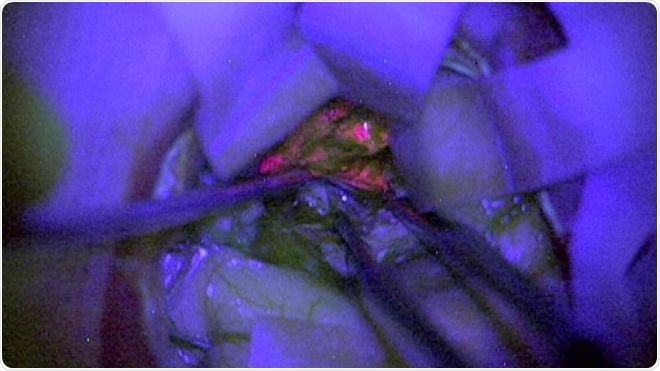A clinical trial has shown that a special chemical makes brain tumours glow pink. This can help neurosurgeons operate easily on them and remove them completely and safely say the researchers. The results of this study would be presented at the 2018 NCRI Cancer Conference in Glasgow between 4th and 6th November 2018.

‘Improving the intra-operative diagnosis of high-grade glioma using a fluorescence biomarker – result of the UK NCRI GALA-BIDD study,’ Kathreena Kurian et al. M
According to the scientists the brain tumours called gliomas are specific. When patients with them consume a drink containing 5-aminolevulinic acid or 5-ALA, it accumulates in the tumour. 5-ALA is known to accumulate in cancer cells that are fast growing. The reason behind this is the fact that the tumours do not contain an enzyme that is necessary to break down the chemical. This chemical contained a pink colour that appeared in the tumours that are most aggressively growing. While operating the surgeon would be able to clearly visualize the tumour tissues and differentiate it from the healthy brain tissues, they add. This can make the operation easier and safer.
Glioma patients are usually treated with a surgery to completely remove the tumour. The chances of survival remain poor in these patients. In this clinical trial 99 glioma patients were included to participate at the Royal Liverpool Hospital, Kings College Hospital in London and Addenbrooke’s Hospital in Cambridge. They all had high-grade or aggressively growing gliomas. The patients were given a drink with 5-ALA just before surgery.
When operating the surgeons looked at the fluorescent tissues of the brain that contained the tumour tissues. In 85 patients they were clearly able to see the tumour tissues as glowing pink. Among these 81 were actually high grade gliomas as confirmed from pathological specimens removed from the brain. One of the glowing tumours was found to be actually low grade tumour. Among the 14 patients in whom there was no glow of the tumours, seven were found to be low grade and seven tumours could not be assessed for their severity.
According to researcher Dr Kathreena Kurian, associate professor in brain tumour research at the University of Bristol, this kind of a operative marker was “urgently needed”. She said it would help guide the neurosurgeons to find the worst bits. “The beauty of 5-ALA is that they can see where high-grade glioma is, while they're operating,” she said.
Lead researcher Colin Watts, Professor of Neurosurgery and chair of the Birmingham brain cancer programme at the University of Birmingham said it was important that neurosurgeons distinguish cancer tissues from healthy tissues. He said, “This is the first prospective trial to show the benefits of using 5-ALA to improve the accuracy of diagnosing high-grade glioma during surgery. These results show that the marker is very good at indicating the presence and location of high-grade cancer cells.” “The advantage of this technique is that it may highlight more quickly high-grade disease within a tumour during neurosurgery. What this means is that more of the tumour can be removed more safely and with fewer complications, and that’s better for the patient,” he explained.
As a next step the team wants to look at patients with low grade tumours and analyse how this tool could be used among them. They explain that for low grade tumours other markers could be useful. The researchers are also planning clinical trials of this marker for children with gliomas. They also plan to assess if this marker can help detect tumours that have come back in the brains after having been successfully removed earlier.
Dr Paul Brennan, from Cancer Research UK in a statement said, “Highlighting the more aggressive tumour cells in real-time could help doctors achieve the delicate balance between removing as much of the tumour as possible while preserving surrounding healthy tissue. The fluorescent marker may also ease the burden of follow-up treatment, as cancer cells left behind after surgery require additional radiotherapy or chemotherapy.”
The National Institute for Health and Clinical Excellence has also given its approval for use of 5-ALA in patients with brain tumours before surgery this year.